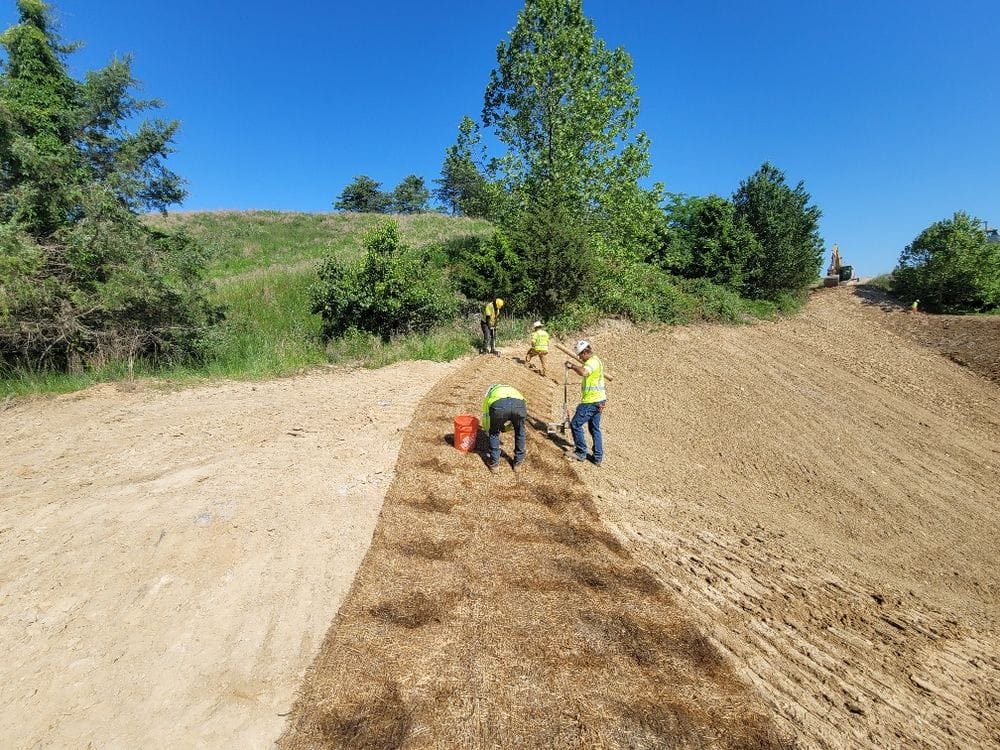Guarding Your Website with Memphis Erosion Control Solutions silt fences
Wiki Article
Best Practices for Erosion Control in Building Projects
Are you functioning on a building and construction project and worried concerning disintegration control? In this short article, we will certainly guide you via the best practices for stopping erosion on your site. silt fences. Get all set to take on erosion head-on and guarantee the success of your construction task.5 Necessary Disintegration Control Techniques

To effectively manage disintegration on your building site, you'll need to apply essential strategies such as slope stablizing and debris control actions. Incline stablizing is critical in avoiding soil disintegration on high slopes. One more efficient method is the use of erosion control coverings or floor coverings, which are positioned on the incline and aid preserve soil particles while permitting plants to expand.
Effective Debris and Runoff Monitoring

You can successfully handle debris and overflow in your construction task by carrying out proper erosion control measures. Debris and overflow monitoring is essential to stop erosion and safeguard the surrounding environment. One reliable step is the setup of silt fences along the perimeter of the construction site. These fencings aid to consist of debris and stop it from entering close-by water bodies. Another crucial practice is the application of erosion control coverings or mats. These blankets supply a protective layer on bare soil, lowering the influence of rains and stopping erosion. Additionally, using debris basins or debris catches can aid to catch debris and stop it from getting in stormwater systems. Normal upkeep of these procedures is essential to guarantee their efficiency throughout the construction job. This consists of cleaning up and inspecting sediment containers and frequently changing silt fences and disintegration control coverings as needed. By executing these disintegration control steps, you can successfully take care of sediment and overflow in your building and construction job, reducing the influence on the environment and abiding by regulative demands.
Key Factors To Consider for Slope Stabilization
When taking into consideration incline stablizing, it is necessary to examine the terrain and determine prospective areas of instability. You require to carefully examine the slope's attributes, such as its angle, drainage, and composition patterns. Seek indications of disintegration, such as exposed origins, cracks, or slumping soil. These signs can provide you an idea of where stablizing actions may be necessary.Once you have recognized the unpredictable areas, you can begin applying steps to stabilize the slope. One usual method is making use of maintaining walls or terracing to produce a series of level actions, which can assist distribute the weight and avoid additional disintegration. Another alternative is to plant plants on the incline, as the origins can assist secure the dirt and control disintegration. In addition, setting up disintegration control coverings or mats can supply immediate defense while plants ends up being well-known.
It's important to on a regular basis monitor the supported slopes to guarantee their efficiency. Keep an eye out for any indicators of activity or erosion, and take prompt activity if necessary. Regular upkeep, such as examining and fixing any kind of damaged actions, is also necessary to make sure long-lasting stability.
Ideal Practices for Plant Life and Soil Protection
One reliable means to safeguard plant life and soil on inclines is by routinely inspecting for signs of disintegration and taking immediate activity if required. Beginning by examining the slope for any kind of signs of disintegration, such as revealed roots, bare dirt spots, or debris buildup at the bottom. Implement disintegration control measures such as mounting disintegration control coverings, mulching, or even creating retaining walls if required.Implementing Proper Drain Equipments
When it comes to handling water flow and avoiding erosion, comprehending these aspects is necessary. Steeper inclines can lead to quicker water flow, YOURURL.com increasing the danger of erosion and flooding. On the various other hand, gentler inclines enable water to flow much more slowly, decreasing disintegration capacity.Sandy dirts have a tendency to drain faster due to their coarse appearance, while clay soils have a slower drain price due to their small nature. Additionally, thinking about the soil qualities helps avoid waterlogging, which can lead to poor plant growth and damages to structures.
Verdict
In conclusion, when it concerns disintegration control in construction jobs, you have to follow these best methods. Apply effective sediment and overflow monitoring techniques to avoid air pollution. Take into consideration incline stablizing methods to ensure the security of the website. Secure vegetation and soil by utilizing proper actions. Lastly, establish proper drain systems to handle water circulation. By following these vital practices, you can effectively manage disintegration and make certain the success of your building job.To properly regulate disintegration on your construction site, you'll require to carry out essential techniques such as incline stablizing and debris control measures. Slope stabilization is important in avoiding soil disintegration on high inclines. An additional effective technique is the use of erosion control coverings or floor coverings, which are positioned on the lawn sprinkler system installation companies slope and aid maintain soil particles while allowing greenery to grow. One more alternative is to plant vegetation on the incline, as the origins can help secure the soil and control disintegration. Implement erosion control actions such as installing disintegration control coverings, mulching, or also building maintaining wall surfaces privacy landscaping if needed.
Report this wiki page